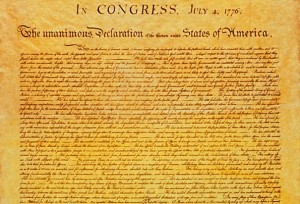By Danny Millum
Magna Carta has inspired some of today’s fundamental liberties, yet it began life 800 years ago as a practical solution to a political crisis. It has since evolved to become an international symbol of freedom, and with the creation of the largest exhibition ever staged about this celebrated document, we now have an opportunity to uncover the story of how its power has been used – and abused – from its genesis through to today’s popular culture.
Due to open this month (13 March–1 September 2015), the British Library’s Magna Carta: Law, Liberty, is part of a series of events to commemorate the 800th anniversary of the granting of the Magna Carta, one of the world’s most famous documents.
Already, the British Library, Lincoln Cathedral and Salisbury Cathedral have made history by bringing the four original surviving Magna Carta manuscripts together in one place, for the first time. At a special screening on 3 February, the manuscripts were viewed by 1,215 people who won the chance to attend the event after entering a public ballot launched last year.
They were followed the next day by a group of world-leading Magna Carta academics who have been studying several hundred other King John charters during the course of a three-year research project. Examining the four manuscripts in context of these other charters, they studied them side by side, scrutinising the handwriting of each of the scribes and considering the evidence of the ownership of the documents throughout its 800 year existence.
The manuscripts have now been returned to their home institutions, and each will be putting on a major anniversary exhibition: the British Library will host Magna Carta: Law, Liberty, Legacy from 13 March–1 September; Salisbury Cathedral will open a new permanent exhibition Magna Carta: Spirit of Justice, Power of Words from 6 March; Lincoln Cathedral‘s Magna Carta will go on display in Magna Carta: Power, Justice and Accountability in the newly-built David P. J. Ross Magna Carta Vault at Lincoln Castle from 1 April 2015.
The School of Advanced Study, in conjunction with the Institute of Historical Research’s (IHR) Reviews in History, will shortly be reviewing the British Library exhibition in depth. We have been promised that it will allow us to explore centuries of dramatic history from King John, medieval battles, revolution, wars, empire and the struggle for the right to vote, right up to today’s satirical commentaries.
The exhibition will bring together, for this once-in-a-lifetime moment, the iconic documents and artefacts that tell the story of Magna Carta. It includes two of the four original 1215 Magna Carta documents, Thomas Jefferson’s handwritten copy of the Declaration of Independence and one of the original copies of the US Bill of Rights, as well as stunning manuscripts, paintings, statues and royal relics.
Julian Harrison, curator of medieval manuscripts at the British Library, has whetted our appetites still further by hinting there are lots of other things in the exhibition that are under embargo until it opens!
The exhibition is sponsored by Linklaters. Using the Magna Carta viewer on the Linklaters website you can examine the document in detail, read it in English and Latin, and discover its key themes.
Danny Millum is deputy editor of the IHR’s online journal, Reviews in History.
The John Coffin Memorial annual palaeography lecture, ‘Who wrote Magna Carta?, will be delivered by Nicholas Vincent, professor of medieval history at the University of East Anglia at Senate House, on 13 May 2015 at 6pm. This free lecture, which is organised by the Institute of English Studies, will be followed by a wine reception.


